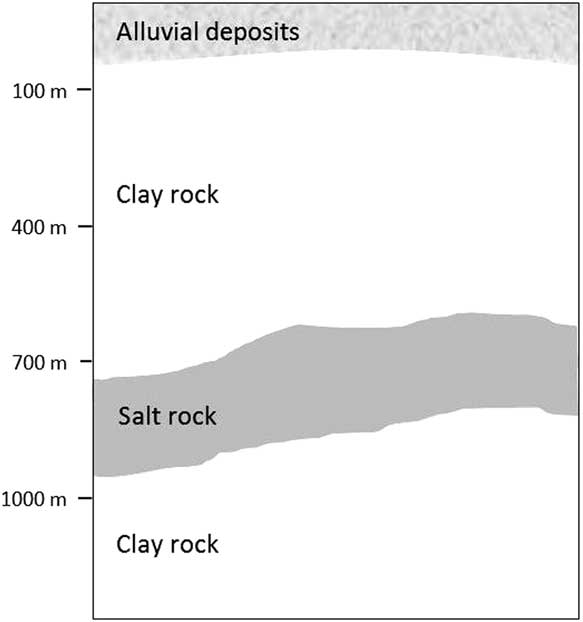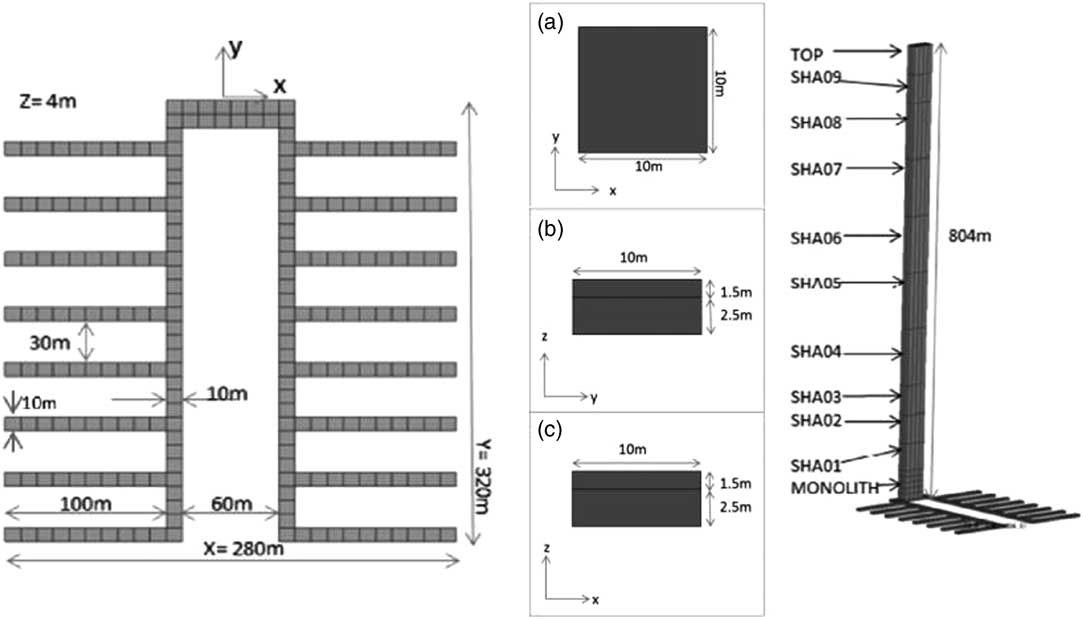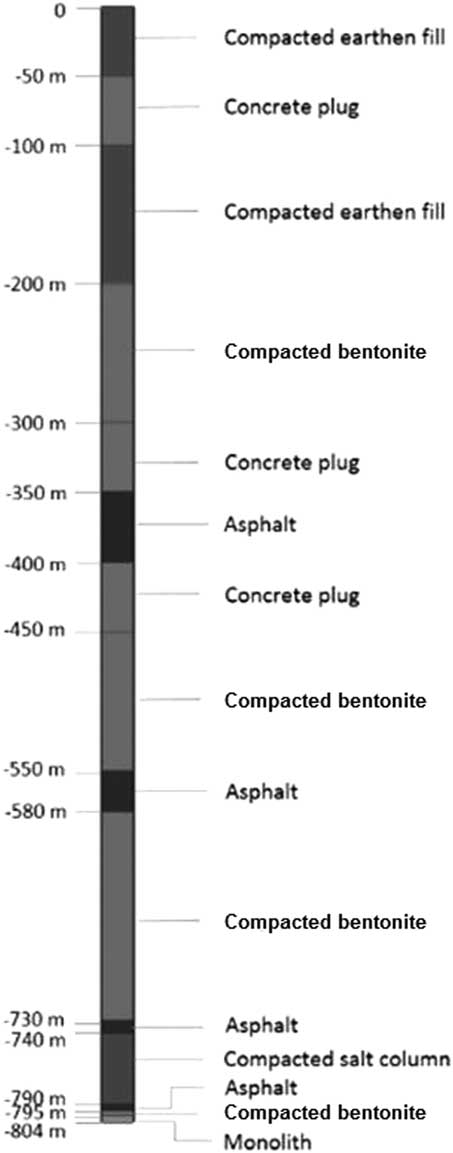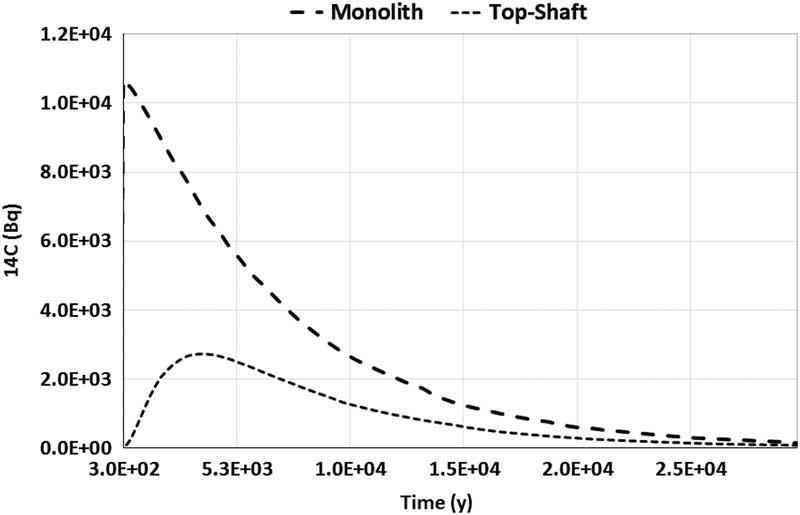INTRODUCTION
The present work has been carried out within the EC CAST project (CArbon-14 Source Term), which aims to develop understanding of the generation and release of radiocarbon (14C) from radioactive waste materials under conditions relevant to waste packaging and disposal in geological repositories. In the framework of different analyses supporting the long-term radiological safety of underground repositories, the migration of 14C into the environment is a key issue. Radiocarbon has a relatively long half-life (5730 yr) and, depending on its speciation, a high mobility in the environment and a high efficiency of incorporation into the human body via the food-chain. During the post-closure phase in the life-cycle of a geological repository, significant quantities of 14C labeled gases (i.e. methane and carbon dioxide) might be produced by corrosion of metals, irradiated graphite and by microbial degradation of organic waste; these chemical species might then be released from the disposal system and reach the biosphere in various ways. The understanding of the key mechanisms influencing 14C transport from the repository to the surface is thus critical in this context and within the safety assessment of geological waste disposal. Therefore, it is important to gain new scientific understanding of different mechanisms dealing with the dynamics of radionuclides inside and outside future repositories.
In Italy, according to international practices, radioactive high level waste-long lived (HLW-LL) and intermediate level waste (ILW) are intended to be disposed of in an underground repository. In the meantime, until a site for underground disposal is selected, these waste products will be placed in a near surface repository for interim storage along with the final disposal of low level waste (LLW). The site for the interim storage has not been yet selected. The model simulations discussed here present a preliminary safety analysis of a hypothetical Italian geological repository hosted in salt rock. In preparation for future assessment studies of post closure safety, the fate of gaseous 14C in geological disposal conditions and its radiological relevance are analyzed. The first phase of this work has consisted in defining the radiological inventory of 14C bearing radioactive waste (HLW-LL and ILW); in a second phase, the evaluation of the radiocarbon release and its dynamic in gaseous phase inside the repository has been evaluated. Three 3D models have been designed and evaluated; their main differences consist of the layout of the underground repository, of the type, features and volume of sealing materials and of the type and volume of waste disposed of. In particular, whereas in the former case, all the waste in the Italian inventory has been considered; in the latter two cases only the irradiated graphite waste (ILW) has been considered. Irradiated graphite generated from nuclear power plant dismantling has been a major issue in past nuclear research, due to various products of activation, including 14C and tritium. These two radionuclides are critical in the context of the safety analysis for both underground and surface repositories, because they are a possible source of radioactive gaseous species. In fact, even today there are uncertainties related to many aspects of irradiated graphite management and disposal, as its interaction with the geochemical environment in which it is disposed, the distribution of the 14C within the waste and the form in which the 14C is released (i.e. organic, inorganic, liquid or gaseous). Some uncertainty also remains for the possible degradation of radioactive waste due to microbial activity in harsh conditions, caused by the absence of water, low porosity and high alkalinity induced by the cementitious near-field of a repository (Grant et al. Reference Grant, Holtom, Rosevear and Widdowson1997; Sorokin Reference Sorokin2005). The behavior of 14C for the final disposal of HLW and ILW has been analyzed in various geological formations, as for example for crystalline rocks by Poskas et al. (Reference Poskas, Grigaliuniene, Narkuniene, Kilda and Justinavicius2016). They have considered the disposal of irradiated graphite in a deep geological repository, evaluating the 14C transfer into the geosphere via the groundwater pathway. The speciation of the released 14C into organic and inorganic species was taken into account. The role of backfill and sealing material in a geological repository is fundamental to retard the migration of radionuclides. Indeed, the hydraulic conductivity of the backfill material for organic 14C, and its distribution coefficient Kd (m3/kg) for inorganic 14C, that quantify the mass partitioning between the solid and the gaseous phase, represent the key parameters influencing the gaseous carbon flux into the geosphere.
MATERIALS AND METHODS
This work has been performed taking into account data of previous Italian studies on the management and disposal of radioactive waste (Luce et al. Reference Luce, Mura, Taglioni and Zarlenga2009) and data of the Italian radioactive waste inventory (Bove et al. Reference Bove, Capone, Cherubini, Compagno, Dodaro and Marlia2009; Capone et al. Reference Capone, Cherubini, Dodaro and Falconi2011). The current inventory of Italian radioactive HLW-LL and ILW containing 14C to be placed in a geological disposal is reported in Table 1. The inventory does not include the residual waste from the reprocessing of irradiated fuel sent abroad (UK and France), to be returned to Italy as vitrified waste.
Table 1 Inventory of Italian HLW-LL and ILW containing 14C.

The conceptual models of the underground disposal facility have been designed by analogy with other existing geological repository projects (e.g. the U.S. Waste Isolation Pilot Plant, WIPP) (Nuclear Waste Partnership LLC 2016; Sevougian et al. Reference Sevougian, Stein and Ham2016). The hypothetical underground facility was assumed to be located to a depth of about 800 meters, hosted in a salt body, 200 m thick, below clay rock about 700 m thick (Figure 1). A geological barrier is guaranteed by the salt rock, isolated from the surface by two different clay formations; the salt formation is considered quite homogeneous, although some discontinuities, as clay inclusions, cannot be excluded. Bentonite, concrete, asphalt and crushed salt have been used as sealing materials inside the underground facility.

Figure 1 Geological stratigraphy of the host rock.
The conceptual models of the waste-repository system have been elaborated considering the source of the 14C. The predominant percentage of 14C in the inventory is related to irradiated graphite, which represents the most important radiological source in the context of Italian 14C bearing radioactive waste. In nuclear power plants, where graphite is used as moderator of nuclear reactions, the production of 14C is related to the activation of 14N, 13C, and 17O, which are the precursor species. The volume of graphite used in this study is referred to as untreated waste and is related to the decommissioning of the shutdown Italian MAGNOX nuclear reactor (Latina NPP).
The analysis about the release and migration of 14C in near-field and far-field of a hypothetical geological repository has been carried out by means of numerical modeling, using the TOUGH2/EOS7R multi-phase code, with PetraSim software as the graphical interface (Oldenburg and Pruess Reference Oldenburg and Pruess1995). In the transport modeling, the sorption of 14C in the solid phase is taken into consideration through the distribution coefficient Kd. The objective of the modeling is to assess both the role of the layout and of the volume of different materials constituting the engineered barriers, and the importance of the Kd coefficient in delaying the migration of 14C, released in the gaseous form from the waste. Although the Kd parameter is a factor related to the partitioning of a radionuclide for the aqueous phase only, and there is no explicit distribution coefficient for the gas phase, in the TOUGH2 volatilization model, the retardation occurs for volatile species in the gas phase, just as it does in the aqueous phase, through the assumption that the gas phase consists primarily of air (Oldenburg and Pruess Reference Oldenburg and Pruess1995).
To evaluate the dynamics of the gaseous radiocarbon in the repository, and to quantify its radiological relevance, three conceptual models have been developed, associated with two different 3D layouts. The first one, referred to a 3D multi-room model (MR), represents a whole system containing all the waste inventory listed in Table 1; three different cases have been simulated (MR1, MR2, MR3) using different volumes of bentonite to seal the underground repository. The latter two conceptual models describe systems containing only the irradiated graphite and are referred to as a 3D single-room model with conservative approach (SRC) and with realistic approach (SRR). In the SRC model four different cases have been simulated (SRC1, SRC2, SRC3, SRC4) using different Kd values for sealing materials; in the SRR model only one case has been simulated. All the models include a single shaft that connects the underground repository to the ground surface. No assumption has been made about the 14C speciation. For what concern the emission from graphite, an important fraction of the 14C is not releasable, because it is strongly bounded to the graphite matrix. Moreover, the total fraction and the fraction of each gaseous species (mainly CO2 and CH4) that migrates outside the waste, depend on the history of graphite (i.e. irradiation history, operational conditions, etc.) (Toulhoat et al. Reference Toulhoat, Moncoffre, Narkunas, Poskas, Bucur and Ichim2018); but due to the lack of information about the Italian graphite inventory, these data are not currently available and conservative assumptions will be used in the simulations.
Since at the moment some aspects of the complex processes simulated in disposal rooms are not known, the elaboration of the conceptual models has been performed with an arbitrary set of conservative assumptions. This approach to conservative parametrization supports aspects of sealing performance studies. Salt formations are favorable rocks to host a geological disposal because they maintain unsaturated conditions; however, salt formations might not be considered completely dry because of the presence of water/humidity related to repository operations and especially because of the presence of brine, that might move from the hosting rock to the excavated zone due to pressure gradient, thermal gradient or rock stress gradient (Rübel et al. Reference Rübel, Buhmann, Meleshyn, Mönig and Spiessl2013; Sandia National Laboratories 2013). This condition, combined with the possible assumption of complete saturation with brine of the disturbed rock zone close to the underground excavation, results in a possible water flow into the repository (Sandia National Laboratories 2006). In this work, a conservative approach has been adopted and the most unfavorable repository conditions have been assumed, considering a constant brine flow into the storage rooms, which can cause the corrosion of carbon steel waste packages and the leaching of 14C from waste. It is assumed that no overpack is provided to contain drums and, in each room, waste is considered as compacted volume. No convergence phenomenon of the host rock has been considered. In all three models, the evolution of described arbitrary scenario has been modeled with two main time steps: the first, from 0 to 300 yr after repository closure, when no release of radionuclides occurs and waste package integrity is maintained (Sullivan Reference Sullivan2004); the second, from 300 yr to 300,000 yr after the repository closure, when steady-state conditions are established, waste packages corrosion and 14C release take place, due to the presence of brine and water inside the repository.
The main purpose of the MR model has been to test the performance of the barrier system in delaying the migration of gaseous 14C, by considering different layouts and volumes of the sealing materials at the repository level. The layout has been designed on the basis of the WIPP project (WIPP 2009). It consists of 16 rooms arranged in two panels, separated by a central pillar of intact salt and connected to the ground surface by a single shaft (Figure 2).

Figure 2 Multi-room conceptual model.
The engineered barrier system includes four materials that completely fill and seal the shaft, rooms and drifts. No disturbed rock zone has been included in this conceptual model; the base of the shaft, after repository closure, consists of a monolith of concrete, 50 m high, 10 m long, and 10 m thick. In each storage rooms, the total amount of the estimated 14C activity is assumed equally distributed within the volume of the waste. The simulations start from a steady-state initial condition calculated assuming an initial pressure of 15 MPa (lithostatic pressure) at the repository level (Kristopher Reference Kristopher2014). This is a conservative assumption that implies, immediately after the repository closure, a lithostatic pressure in the storage room. During all the computation time, this conditon, assuming a constant gas production within the storage rooms, generates a pressure profile that provides a gas flow from the underground repository to the top of the shaft. In this scenario only migration by diffusion has been modeled. The source term is modeled as a gaseous emission of 14C with a release rate of 10% per year of the total activity; this highly conservative and unrealistic release rate has been intended to force the model to produce results that bring out the effects of different features of the sealing materials on the 14C migration. In order to make a preliminary sensitivity analysis, the volume of bentonite has been selected as the focus of the sensitivity analysis, because of its very low permeability and its capacity to retard most radionuclides by sorption (Daeman and Ran Reference Daeman and Ran1997). Three case studies have been developed; in MR1 case, no bentonite is used to seal the underground facility; in MR2 case, a bentonite volume of 3657 m3 is placed around the lower part of the monolith (underground shaft closure); in MR3 case, a bentonite volume of 9508 m3 is distributed along the entrance of every disposal room and around the base of the monolith (Figure 3).

Figure 3 Sealing materials configuration in the MR model.
In these cases, generic features have been used for the sealing materials. According to Yim and Caron (Reference Yim and Caron2006), a Kd value of 1.0E-5 m3/kg has been assumed for asphalt, waste form and concrete monolith, while Kd = 0 for the crushed salt and intact salt; because of its sorption capacity, a high Kd value (1 m3/kg) for bentonite has been assumed (Daeman and Ran Reference Daeman and Ran1997). The layout of shaft sealing materials has been maintained constant in all cases (Figure 4).

Figure 4 Sealing materials for the shaft in the MR model.
In the SRC model, a new barrier system configuration has been taken into account, based on Freeze et al. (Reference Freeze, Gardner, Vaughn, Sevougian, Mariner, Mousseau and Hammond2013), and only irradiated graphite is considered. Only one storage room has been considered, containing 196 hypothetical waste packages, each with a volume of 1 m3. All the activity of 14C related to the irradiated graphite is assumed equally distributed throughout these packages. Crushed salt, waste form and shaft seal materials constitute the repository barrier system. A disturbed rock zone, 10 m thick, has been modeled as volume of rock, surrounding the excavated zone, that experiences durable changes in hydraulic parameters, as porosity and permeability (Freeze et al. Reference Freeze, Gardner, Vaughn, Sevougian, Mariner, Mousseau and Hammond2013). The source term is modeled as a gaseous emission of 14C, characterized by a constant release rate of 0.0067% per year of the total 14C activity contained in graphite (Fugaru Reference Fugaru2018). Where not specified in the following description, input data assumed for the simulations are the same assumed for the MR model. Figure 5 illustrates the configuration of materials featuring the shaft sealing, as defined for a generic vertical shaft in US WIPP, that consist of concrete, asphalt, salt and bentonite, to enhance physical and chemical barrier to radionuclide migration. The values of their main parameters are reported in Table 2. A small inverse Henry’s constant has been assigned, such that gaseous 14C mostly volatilizes leading to a worst case scenario (Oldenburg and Pruess Reference Oldenburg and Pruess1995). Four main cases have been simulated (SRC1, SRC2, SRC3, SRC4), starting from the most conservative assumption (SRC1) in which, for all the sealing materials, the Kd value is 0. In the other three cases, a Kd value of 1.0E-5 (m3/kg) has been assumed for the waste form, the bentonite, the concrete and the asphalt (Table 3).

Figure 5 Sealing materials for the shaft in the SR model.
Table 2 Values of main parameters of the sealing materials used in the simulations.

Table 3 Kd (m3/kg) values of the sealing materials used in the simulations.

The SRR model has been developed in analogy with the previous one. To evaluate the radiological impact of 14C in a more realistic way, a less conservative approach has been assumed by using a Kd > 0 for all sealing materials (Table 3). The main features of the previous conceptual model have been preserved. In this simulation, the release of 14C from the irradiated graphite has been analysed with a more detailed approach. According to Doulgeris et al. (Reference Doulgeris, Humphreys and Rout2015), two main dynamics featuring the behavior of 14C have been considered; first, the CO2 and CH4 released from graphite are partitioned between the solution and the gas phase, according to the Henry’s law. The second is related to the contribution of cementitious materials in attenuating 14C migration, because of CO2 carbonation; in fact, as highlighted by Poskas et al. (Reference Poskas, Grigaliuniene, Narkuniene, Kilda and Justinavicius2016), encapsulation of graphite inside a container with cementitious material would decrease the maximum flux of inorganic 14C into the geosphere, by approximately one order of magnitude. Methane is the predominant form of gaseous 14C considered for this case, with no adsorption capacity into the salt rock formation (Kd = 0 m3/kg). A congruent release of gaseous 14C starts 300 yr after the repository closure, with a release rate of 0.0067% per year, as gaseous 14CH4 (Fugaru Reference Fugaru2018). Migration is assumed to take place only by diffusion.
RESULTS AND DISCUSSION
The 14C amount was calculated for two specific blocks common to the three models: near the compacted hearten fill at the top of the shaft, and near the concrete monolith at the base of the shaft. The results of the multi-room and single-room models are not comparable, because of the different discretization and conceptualization of the models; therefore, the data are reported in different graphs. The simulation results of the MR model, cases MR1 and MR2, show that, at the base of the shaft in the monolith, the presence of a bentonite volume of about 3600 m3 leads to a decrease of 3% of the cumulative amount of 14C. Increasing the bentonite volume of about three times, from case MR2 to case MR3, the amount of 14C decreases of 23.5%, from 2.3E10 Bq to 5.3E09 Bq (Figure 6).

Figure 6 Cumulative amount of 14C in the monolith at the base of the shaft (MR model).
In all three cases, due to the large volume of bentonite (about 4.0E05 m3) and due to the other sealing materials in the shaft, the maximum cumulative amount of 14C at the top of the shaft is orders of magnitude lower than in the monolith at the base of the shaft (about 2.3E-1 Bq in the case MR1, about 1.4E-2 Bq in the case MR2 and about 2.0E-3 Bq in the case MR3) (Figure 7).

Figure 7 Cumulative amount of 14C at the top of the shaft (MR model).
The simulation results of the SRC model (cases SRC1, SRC2, SRC3, SRC4) show that sealing materials with values of Kd lower than 1.0E-5 m3/kg do not affect the cumulative amount of the gaseous 14C, with quite similar results in all the four cases. The peak of 14C amount at the top of the shaft occurs at about 4000 yr after the repository closure, with a maximum value of 2.7E03 Bq. After 300,000 yr, the 14C amount at the top of the shaft becomes negligible in all the simulated cases, decreasing to a minimum value of about 1.0E-15 Bq. The peak of the 14C gaseous emission in the monolith at the base of the shaft occurs about 400 yr after the repository closure with value of about 1.0E04 Bq (Figure 8).

Figure 8 Cumulative amount of 14C (SRC1 case, representative of the four cases simulated).
In the SRR model, the peak of the 14C gaseous emission at the top of the shaft, occurs about 17,000 yr after the repository closure with about 1.4E02 Bq. Also in this case, the peak of the 14C gaseous emission in the monolith occurs about 400 yr after the repository closure with value of 1.0E04 Bq (Figure 9).

Figure 9 Cumulative amount of 14C (SRR model).
CONCLUSION
The paper reports a preliminary analysis of the radiological impact of gaseous 14C from HLW-LL and ILW disposed in a hypothetical Italian geological repository hosted in salt rock. Before this work, no safety assessment or generic safety studies had been developed in the Italian context for geological disposal. The three conceptualizations of the underground facility, and the following simulations, have improved the knowledge about the future safety issues that will have to be discussed for final disposal of Italian HLW-LL and ILW. The results of the MR model confirm that the capacity of materials to retard radionuclides migration depends on their Kd value and their volume in the repository. High values of Kd significantly affect the barrier system performances. From detailed analysis of the simulation results of the MR model, taking into account the cases 2 and 3, it is evident that, for high values of Kd, the performance of the sealing materials is proportional to their volume and density. Increasing the total volume of the bentonite by about three times, moving from the case 2 to the case 3, the cumulative amount of 14C in the monolith is reduced of about one order of magnitude (from 2.3E10 Bq to 5.3E09 Bq). At the top of the shaft, in all three cases, the significant decrease of the cumulative amount of 14C, with respect to the monolith, depends mainly on the large volume of bentonite and of the other sealing materials in the shaft. In the SRC and SRR conceptual models, a more realistic scenario than the MR model has been simulated. In particular, in SRR model a release rate of 0.0067% per year and a Kd > 0 for all the sealing materials have been assumed. The maximum value of the cumulative amount of 14C calculated in the SRR model at the top of the shaft (1.4E02 Bq) is about one order of magnitude lower than the cumulative amount calculated in the cases of the SRC model (2.7E03 Bq).
The results of this study show that, if disposed in a hypothetical geological repository hosted in salt rock, a low radiological impact of 14C from the Italian graphite waste and other HLW-LL and ILW can be expected. The mitigation of 14C migration towards the surface, and the following reduction of the radiological impact, are related to the combined actions of the low conductivity of salt host rock, of the adsorbing capacity of sealing materials and of the radioactive decay. Moreover, the conservative assumptions used in the various simulations (i.e. saturation with brine for all the calculation time, relatively high permeability of the disturbed rock zone and backfill around the waste packages, etc.) might have produced overstated values of 14C at the top of the shaft.














